


Want to build a healthcare app but don’t know where to start or how to plan your budget?
In this guide, we’ll walk you through every step — from budgeting and scoping to choosing the tech stack and releasing your app. Whether you're planning a simple symptom checker or a full-scale telemedicine platform, you'll learn what it takes to turn your idea into a working product.
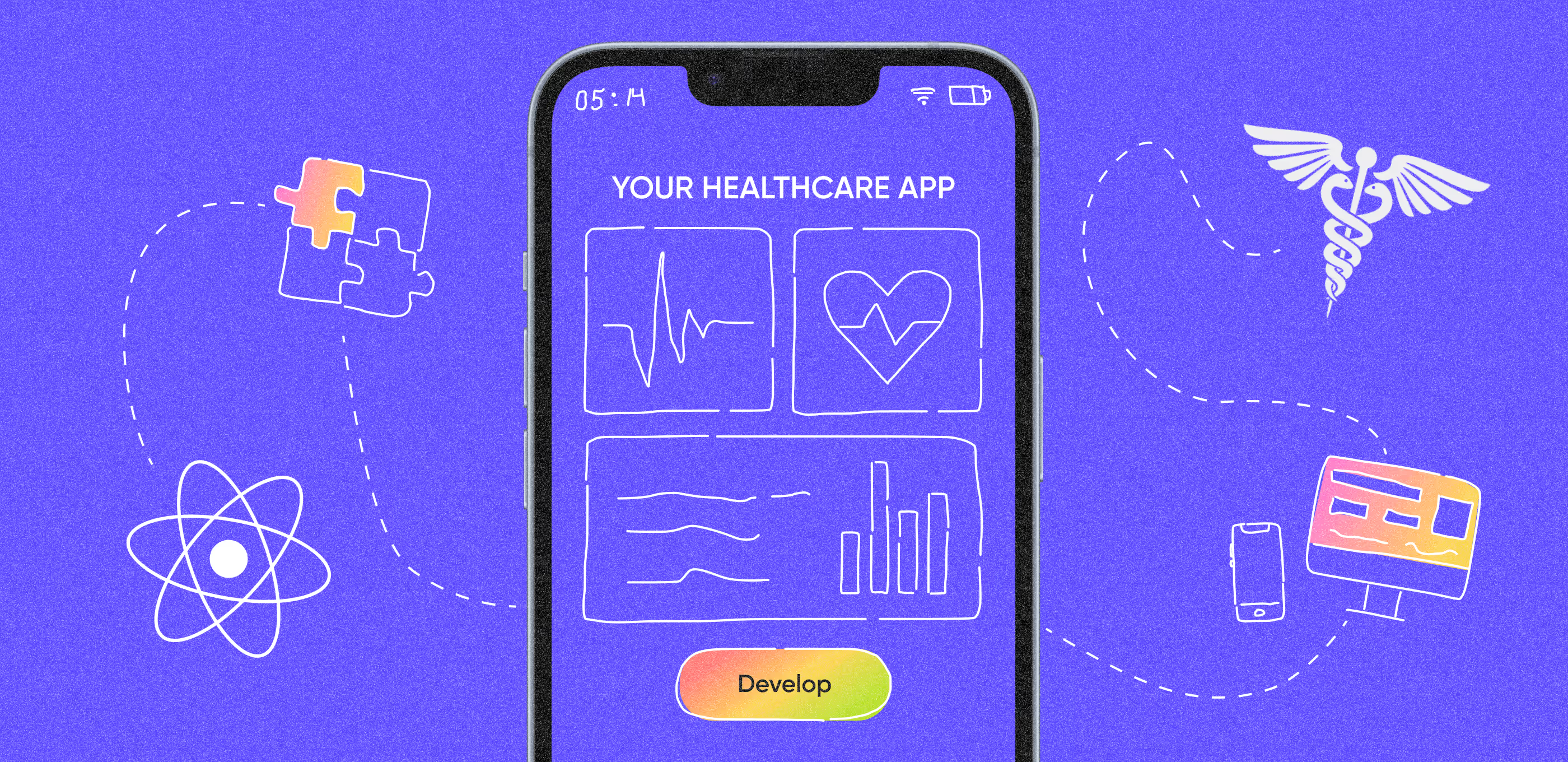
Mobile health apps are growing in demand. In 2024, 43% of the US population used health apps to track nutrition, symptoms, or medication. As more users rely on these apps, there is increased pressure to build secure, compliant, and reliable digital health solutions.
Healthcare app development in 2026 comes with a wide price range: from $40,000 for an MVP to $300,000+ for a full-featured, compliance-heavy platform. The price may seem high. However, it reflects the complexity of working with sensitive health data, strict regulatory standards, and the need for secure infrastructure. Unlike basic mobile apps, healthcare products must be built with compliance, scalability, and user safety in mind.
Let’s break it down.
In the healthcare industry, the cost of app development varies based on what you build and who the end users are. Typically, startups and healthcare providers spend around $80,000 to $150,000 for a mid-level healthcare mobile app. If your product is simple like a symptom checker, wellness tracker, or appointment booking tool, you might stay within the $40,000-$80,000 range.
But if you're building something advanced like a telemedicine platform or an EHR system with AI, video calls, or live data, expect to pay $250,000+. These healthcare apps take longer to develop, and security is non-negotiable.
An MVP, or Minimum Viable Product, is a version with basic features. Its development helps you test your idea and get user feedback. Building an MVP usually costs between $40,000 and $80,000. This way, you can launch faster and spend less at the start.
<div class="post_divider"></div>
⭐Our experience
For example, the Clearstep startup began with just an idea and a small budget of $1,500.
Our team created a clickable prototype of a healthcare app in just 1.5 weeks with a clear, modern design. This prototype helped Clearstep secure $400,000 in investments and laid the foundation for further product development.
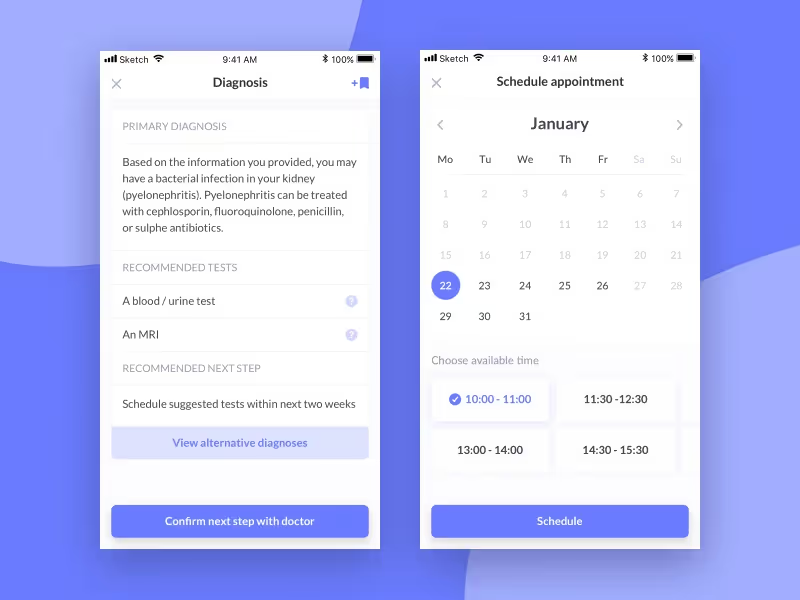
One more example is the development of a user-friendly web platform inspired by psychological GSR methodology.
We developed a basic MVP with a catalog of psychologists, a matching questionnaire, and adaptive design — in just 4 months for $40,000. This helped test the idea and scale the platform later.
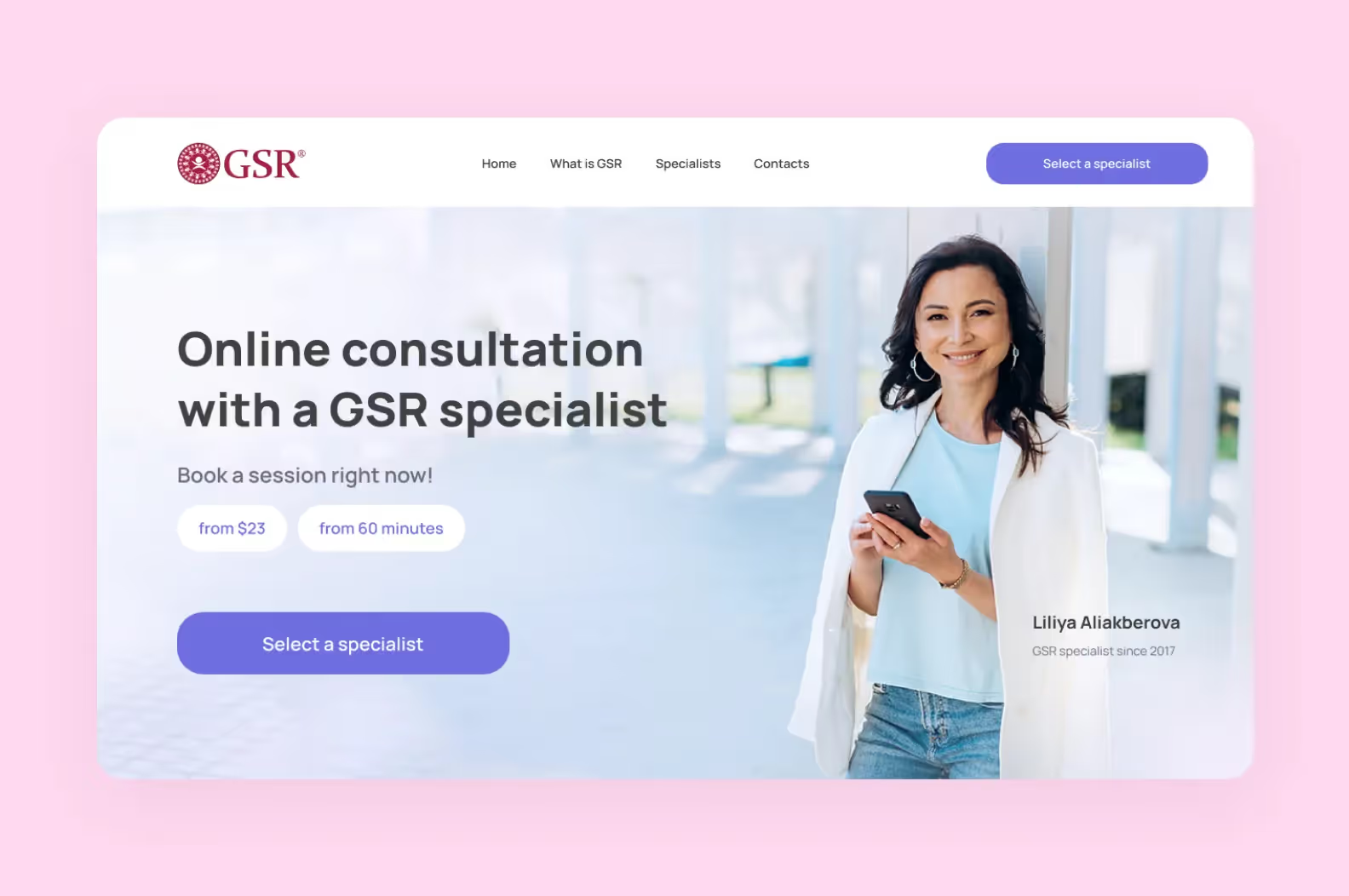
<div class="post_divider"></div>
A full product is a complete healthcare app with basic and additional features. It usually costs from $100,000 to $300,000+. Full products have more tools, better design, and stronger security measures.
Let’s explore the main cost drivers — from feature complexity to team composition — and explain how each influences your final development bill.
The cost of a healthcare mobile app mainly depends on the set of features and their complexity.
Basic features are easier and cheaper to make. These include user sign-up, profiles, booking appointments, push notifications, and simple dashboards. They don’t need complex designs and complicated backend systems.
Development of more advanced features makes costs go up. Connecting with Electronic Health Records (EHR) systems needs secure and reliable ways to exchange data. Features like real-time chat and video calls require strong backend support that can handle lots of users without delays. AI tools like symptom checkers or diagnostics can increase development costs even more.
<div class="post_divider"></div>
⭐Our experience
A good example of complex healthcare app development is an online psychotherapy service we built for the UK market.
We developed a web platform and mobile app that included real-time video calls, therapist verification, and integration with an outdated insurance system API. The app launched with 1,000+ users and 30 therapists.
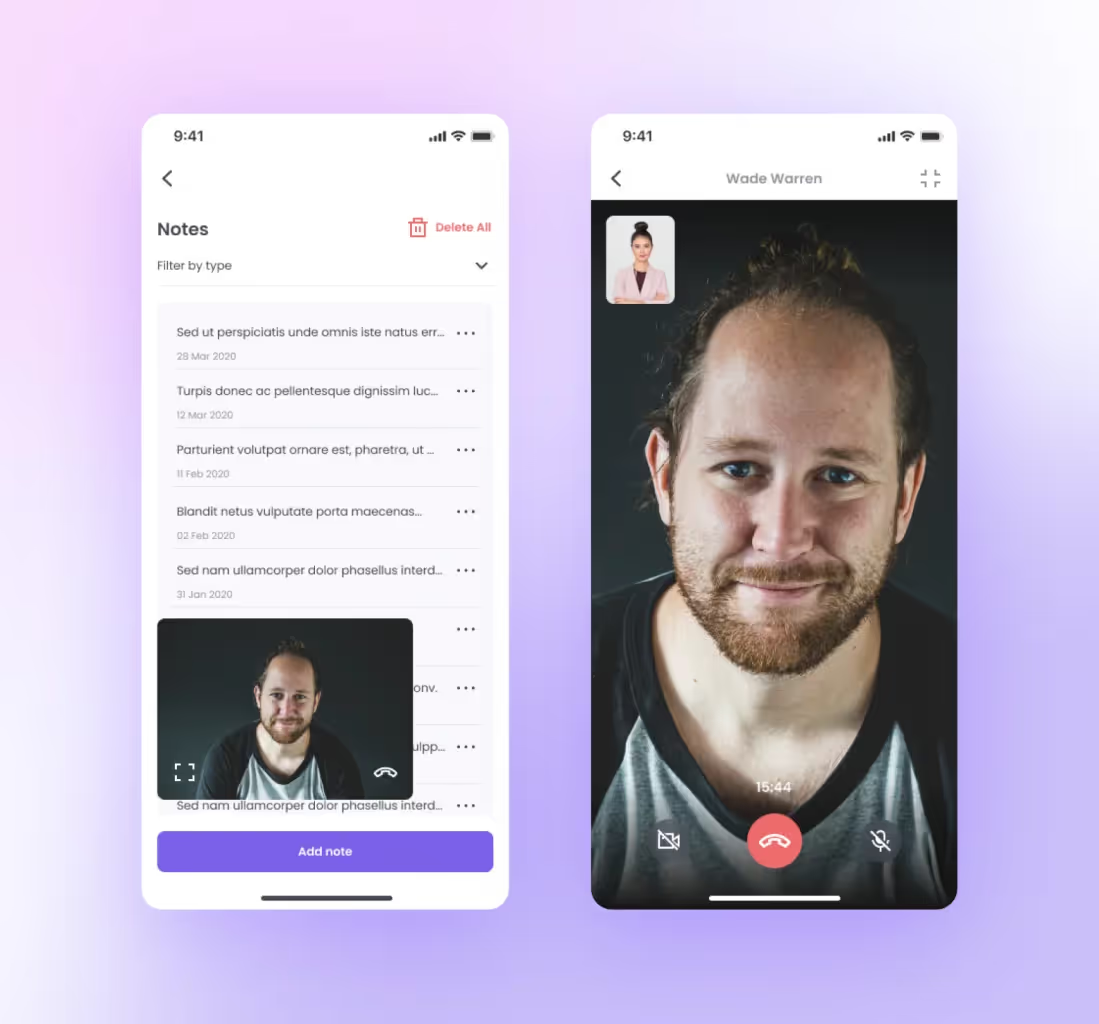
<div class="post_divider"></div>
Other things that affect the price include the number of screens, the complexity of the user flow, and the app logic. For example, a wellness app that tracks habits and builds reports needs more complex frontend and backend development than a basic appointment booking tool.
The type of healthcare app you’re building also influences its cost. Each app type needs different features, levels of security, and tech setups.
Effective design in healthcare apps means creating safe, easy-to-use, and inclusive experiences, not just attractive interfaces. Gathering user feedback throughout the design and development helps ensure the app meets the needs of its audience.
You can use a standard UI. It means the app consists of ready-made design elements and templates. This speeds up the development process and keeps costs lower. It works well for apps aimed at general users with simple needs.
However, if your app serves specific users like older adults, doctors managing electronic health records, or people with disabilities, then a custom design is better. This includes clear navigation, helpful animations, and tailored user flows. Custom design makes the app easier to use but increases design and development costs by 20-40%.
It’s important to consider accessibility during development to ensure healthcare apps work well for users with vision, hearing, or motor disabilities. This means adding screen reader support, large fonts, high-contrast modes, and simple buttons.
On top of that, apps must follow HIPAA design rules. This means protecting user data through secure login screens, showing clear privacy messages, and keeping sensitive information safe.
Who builds your healthcare mobile app matters as much as what you’re building.
You can go with an in-house team, an outsourced partner, or a mix of both.
Costs also depend on the size and composition of the development team:
When everyone knows their role and works well together, the whole development process goes faster, and you avoid extra costs.
Geography plays a crucial role in the development costs.
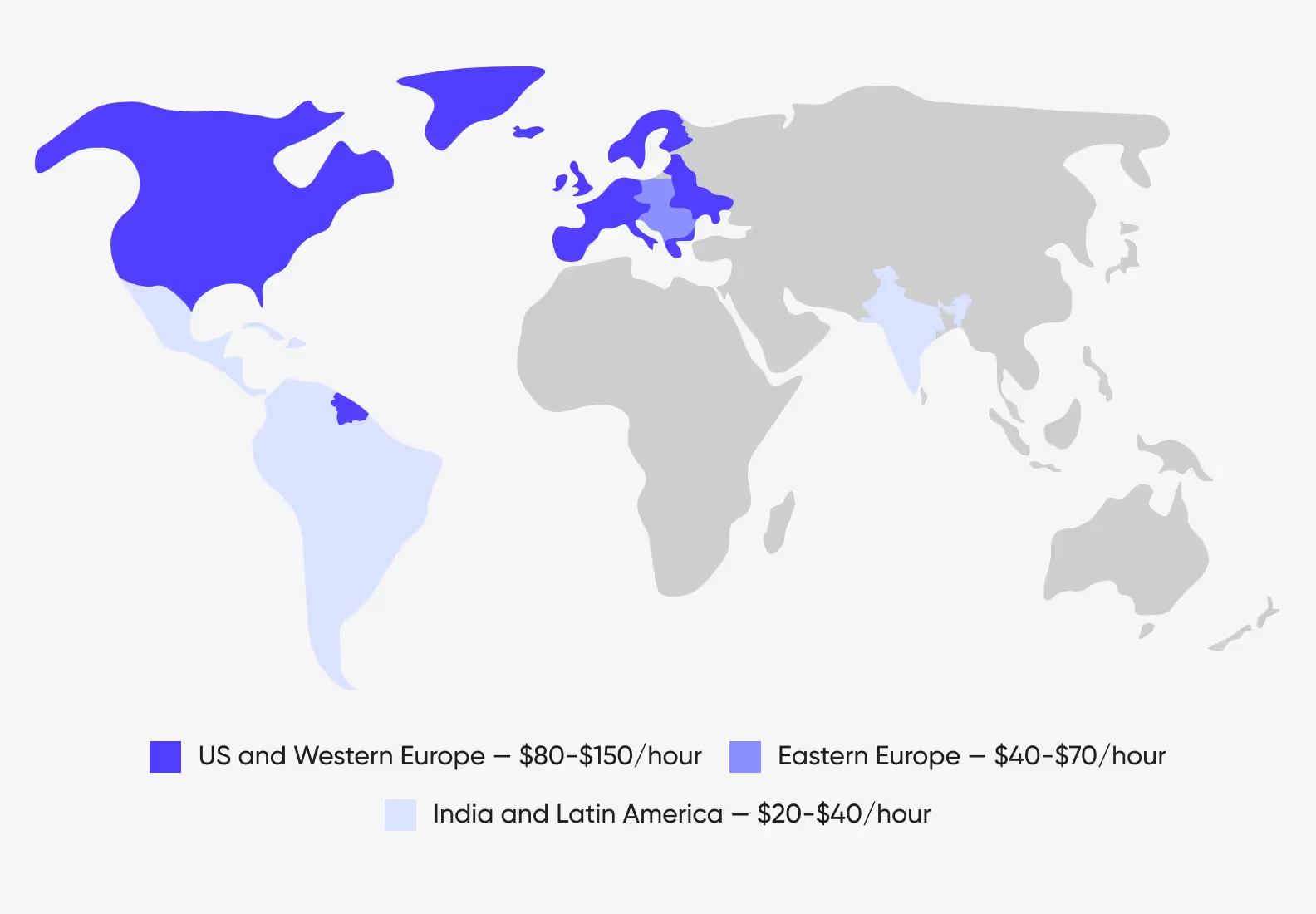
Choosing a development team involves trade-offs between cost, quality, cultural fit, and collaboration efficiency. For healthcare apps, where compliance and quality are critical, balancing cost with expertise is essential.
One of the first choices that healthcare organizations face is whether to develop the app for iOS, Android, or both.
If you build two separate native healthcare apps — one for iOS and one for Android — you’ll get top performance and a great user experience. But this also means twice as much work, which will lead to more time and higher costs for the development process.
Many teams go with cross-platform development using tools like Flutter or React Native. This way, one codebase works for both platforms. It’s not always 100% perfect in look and feel, but it’s good enough and much cheaper.
If your users are on one platform, like iOS, you can start there and add Android later. But if you’re targeting a wide audience, support both from the start.
Healthcare apps are not limited to mobile devices. Many doctors, administrators, and patients prefer using web versions on their computers. Purrweb develops web applications using React.js — these apps run smoothly in any modern browser. They are quick to build and easy to update without the need to go through app stores.
For desktop solutions such as hospital management tools or clinic dashboards, Purrweb utilizes Electron.js. The technology allows us to create cross-platform desktop software. This approach reduces development time and costs compared to building native Windows or macOS applications from scratch.
Healthcare professionals spend a lot of time at their desks, so having web and desktop versions from the start is practical and cost-effective. This approach aligns well with our strong experience in healthcare and wellness app development.
For healthcare providers, ensuring compliance and protecting sensitive patient data is not optional — it’s a core requirement. Healthcare app development deals with private and sensitive data, so platforms have to follow strict rules to keep that information safe.
In the US, apps must follow HIPAA rules. In the EU, it’s GDPR. These laws protect personal data and require strong security.
There are also healthcare-specific standards like HL7 and FHIR, which make sure medical systems can share data in the right format.
Developers need to spend extra time securing data storage, encrypting messages, activity logs, and creating privacy-friendly design. This can add about 15-30% to the total cost of building the healthcare app.
Skipping compliance isn’t an option: it can lead to big fines and damage your reputation. So it’s always better to include it in the development strategy.
Building the app is just the start. Healthcare apps need ongoing maintenance for security patches, OS updates, and new feature requests.
Budgeting for maintenance — typically 15-25% of the initial healthcare app development cost annually — is critical to keep the app functional and compliant.
Support contracts and quick response times may add to costs but are vital for vital healthcare applications.
Integrations can be some of the most time-consuming and costly parts of development.
Scope each integration individually. Some may add tens of thousands of dollars to your project.
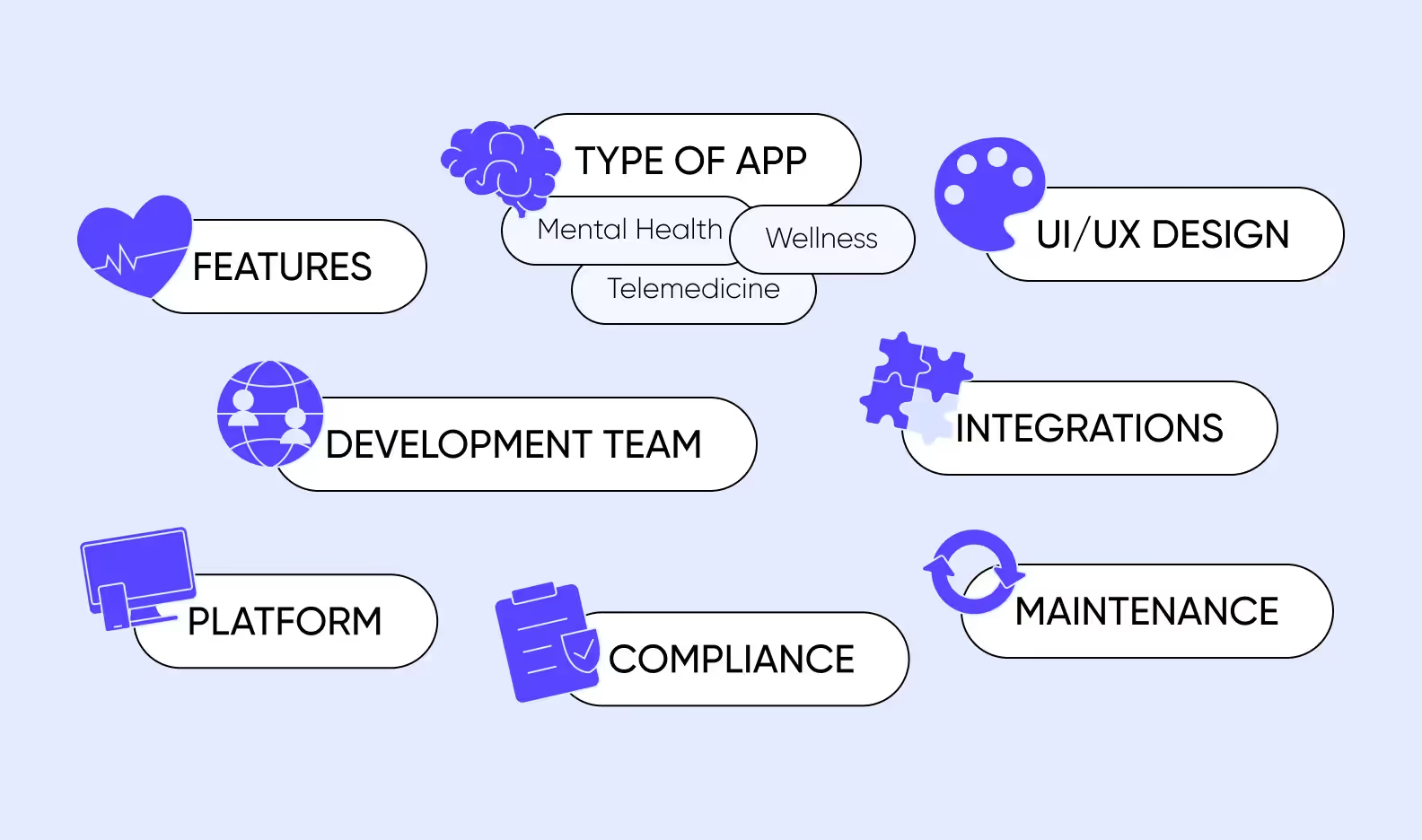
Here’s a quick overview of popular healthcare app types and their average development costs.
These healthcare apps let doctors and patients talk remotely. They are harder to build because they need to be secure and work in real-time. Also, they must handle payments at times. Telemedicine app development typically costs between $80,000 and $300,000+.
Apps for mental health or meditation have mood tracking, guided sessions, journals, and sometimes community features. They are simpler in terms of backend, but need to be attractive and easy to use, so people keep using them. These healthcare app development generally cost between $60,000 and $120,000.
Wellness apps track activities like exercise, nutrition, sleep, and other health data. They can connect with smartwatches or fitness bands, which means extra work to link up and sync data in real time. Developers can create simple fitness apps for $55,000 to $80,000, while development of more advanced apps with social or personalized features might cost up to $150,000.
These are large, complex healthcare systems used by hospitals to manage patient records, staff schedules, billing, and supplies. They often need customization. These projects usually start around $150,000 and can go over $400,000.
Electronic Health Record and Electronic Medical Record apps let patients and doctors access medical history, test results, and prescriptions. Creating safe patient portals that follow healthcare data rules requires a lot of backend and security work. The development of these apps costs between $900,000 and $250,000.
AI assistants and chatbots help patients check symptoms, remind them to take medicine, and answer common questions. They need special AI technology and training. The development of these apps can cost from $70,000 to $350,000+.
When planning the cost of a healthcare app, it’s common to focus on development hours and features. Knowing about “hidden costs” upfront helps avoid budget surprises and keeps your project on track.
Your healthcare app needs reliable servers and storage to work. Using cloud services like AWS or Azure isn’t free, so expect monthly fees based on your user count, data storage, and computing needs.
For small apps, development costs start around $50-$200 per month. Medium projects pay $200-$1,000 monthly, while large, high-traffic apps can spend $1,000 or more. Infrastructure setup, scaling, backups, and monitoring all come with costs as well.
After the release, you’ll need to monitor performance, fix bugs, and release updates. Users may find issues you didn’t catch during testing. Allocating about 15-25% of your initial healthcare app development costs for ongoing maintenance is a good rule of thumb.
Publishing your healthcare app to stores like the App Store or Google Play involves fees. Apple charges $99/year for developer accounts, Google Play charges a one-time $25 fee. However, there may also be costs for certificates, licenses, and renewals. These are small compared to development but still worth budgeting.
As we mentioned before, for healthcare apps, security is critical. The projects require third-party security audits to check for vulnerabilities and compliance. Small and medium projects usually pay $5,000 to $15,000 for a basic security audit. Larger, complex projects with critical infrastructure and sensitive data may pay $20,000 to $50,000+, depending on the scope.
Legal reviews, including checking terms, privacy policies, and contracts, cost $3,000 to $10,000 for standard software. For development of highly regulated apps, legal fees can reach $20,000 or more.
Building a healthcare app can be expensive, but smart planning lets you save money without cutting corners. Here are some proven ways to keep costs down.
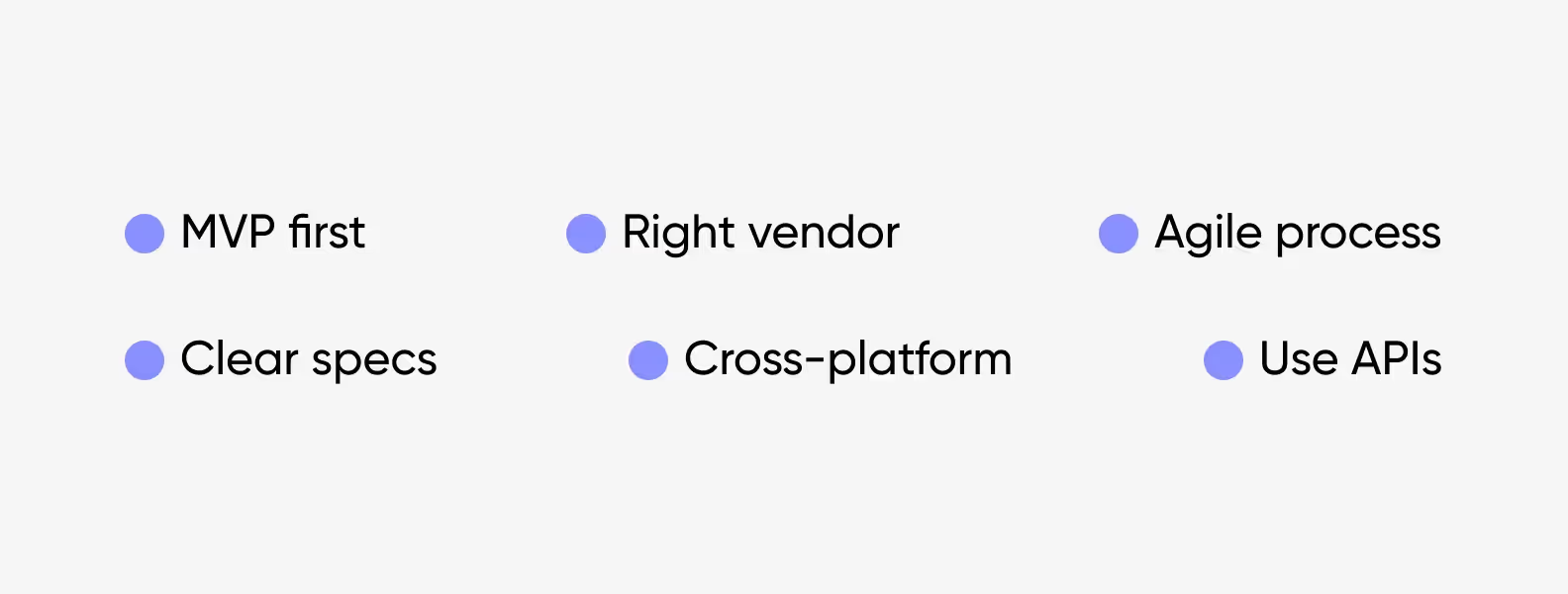
For businesses and healthcare providers who want to launch a digital product quickly, it’s important to focus on basic features that make the app work well. Instead of building everything at once, create an MVP. This lets you launch faster and get real user feedback before investing in extra features.
Instead of building separate apps for iOS and Android, consider cross-platform development. React Native and Flutter let developers write one codebase that works on both platforms. This approach saves development time and cuts costs by 30%. Just make sure your healthcare app works well with cross-platform tools.
If you decide to outsource development, pick your partner carefully. Look for companies with experience in healthcare apps, good reviews, and clear communication. A reliable team will avoid costly mistakes, meet deadlines, and help with compliance requirements.

Don’t reinvent the wheel. The common healthcare features, like appointment scheduling, payment processing, and video calls, can be built faster by using existing APIs and software frameworks. This cuts development time and lowers costs. For example, integrating Twilio for chat or Stripe for payments saves months of work. Just ensure these third-party tools meet your security and compliance standards.
Working with teams that use Agile or SCRUM helps organize work in short, focused cycles called sprints. They usually last two weeks. This method allows you to see progress regularly, give feedback early, and adjust the plan as needed.
Agile helps avoid wasted effort on features that users don’t want and catches issues sooner. It also improves team communication and speeds up delivery. Choosing a development partner with strong Agile experience means your healthcare app budget is spent wisely and transparently.

One of the biggest cost traps is changing requirements late in the development process. Last-minute changes often lead to rework, delays, and extra expenses. To avoid this, spend time upfront creating clear and detailed specifications. When everyone — developers, designers, and stakeholders — understands exactly what to build, the project runs smoothly and stays on budget.
Picking the right technologies for your healthcare app is important. It affects how quickly the team will build the app, its performance, and the overall cost. A good tech stack also helps you avoid expensive fixes later.
The backend is the engine that runs your app behind the scenes. Popular choices in the healthcare industry include Node.js, Ruby on Rails, and Python.
Node.js is great for real-time features like chat and video calls — it’s fast and scalable. Ruby is known for quick development and simplicity, which reduces costs. Python shines in projects involving AI or data processing, but it may be slower for real-time needs.
For mobile healthcare apps, you can build native apps or use cross-platform frameworks.
Native apps offer the best performance but cost more since you develop two separate apps. For iOS apps, developers use Swift and Objective-C, for Android — Java and Kotlin.
React Native and Flutter let you write one codebase for both platforms, saving time and money. Development is generally faster with React Native, especially if the team knows JavaScript. Flutter offers smooth animations and consistent UI, which is useful for healthcare apps with patient dashboards or real-time monitoring.
Your app needs reliable cloud services to store data and run smoothly. The main players are AWS, Microsoft Azure, and Google Cloud Platform (GCP). AWS is a popular choice with many tools and global reach. Azure works well if you use Microsoft products, and GCP is known for strong data and AI services.
All three offer tools that simplify backend development, monitoring, and scaling — all of which are critical for HIPAA-compliant healthcare solutions.
Healthcare apps must protect sensitive data. Services like Auth0 and TrueVault help manage secure user authentication and store health data safely. This facilitates compliance with laws like HIPAA. Building custom digital health solutions is possible, but development is costly and time-consuming. Using trusted compliance tools can save money and reduce risks.
Tracking user behavior and using AI can improve your healthcare app. Tools like Mixpanel and Firebase offer ready-made analytics that are easy to set up. For advanced AI features, you may need custom models built with Python or TensorFlow. Off-the-shelf tools save time and cost but may have limits, while custom AI is powerful but expensive.
Building a healthcare app is a big step, both in impact and investment. Whether your budget is $50,000 or $300,000+, knowing what to expect at each stage helps set clear goals. A smaller budget can cover an MVP with core features, while a larger budget allows for advanced functions, integrations, and custom design.
No matter the budget, thoughtful preparation and partnering with the right development team are the best ways for healthcare providers to make your healthcare app a success without overspending.
➡️ At Purrweb, we have healthcare experience and focus on compliance and modern tech. Our team helps clients turn ideas into working products. The development approach emphasizes smart planning, clear specifications, and choosing the right tech stack to avoid delays and extra costs. <a class="blog-modal_opener">Fill out the form</a>, and you’ll get a free project estimate within 48 hours.